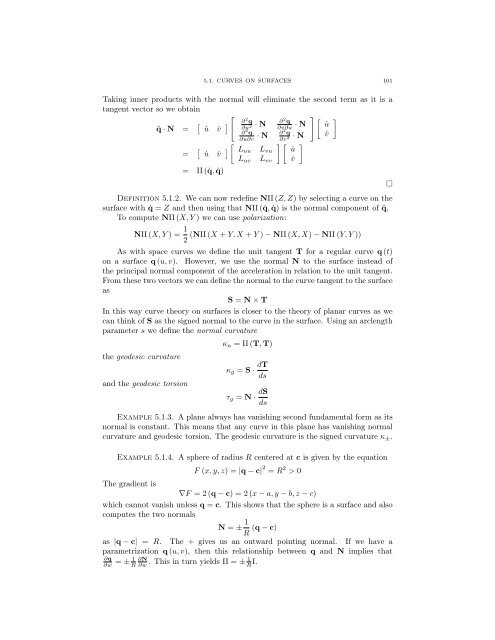Lecture Notes for 120 - UCLA Department of Mathematics
Lecture Notes for 120 - UCLA Department of Mathematics
Lecture Notes for 120 - UCLA Department of Mathematics
You also want an ePaper? Increase the reach of your titles
YUMPU automatically turns print PDFs into web optimized ePapers that Google loves.
5.1. CURVES ON SURFACES 101<br />
Taking inner products with the normal will eliminate the second term as it is a<br />
tangent vector so we obtain<br />
¨q · N = ⇥ ˙u ˙v ⇤ " #<br />
@ 2 q<br />
@u<br />
· N @2 q apple 2 @v@u · N<br />
@ 2 q<br />
@u@v · N<br />
@2 q<br />
@v<br />
· N<br />
˙u˙v<br />
2<br />
= ⇥ ˙u ˙v ⇤ apple L uu L vu<br />
L uv L vv<br />
apple ˙u˙v<br />
= II(˙q, ˙q)<br />
Definition 5.1.2. We can now redefine NII (Z, Z) by selecting a curve on the<br />
surface with ˙q = Z and then using that NII ( ˙q, ˙q) is the normal component <strong>of</strong> ¨q.<br />
To compute NII (X, Y ) we can use polarization:<br />
NII (X, Y )= 1 (NII (X + Y,X + Y ) NII (X, X) NII (Y,Y ))<br />
2<br />
As with space curves we define the unit tangent T <strong>for</strong> a regular curve q (t)<br />
on a surface q (u, v). However, we use the normal N to the surface instead <strong>of</strong><br />
the principal normal component <strong>of</strong> the acceleration in relation to the unit tangent.<br />
From these two vectors we can define the normal to the curve tangent to the surface<br />
as<br />
S = N ⇥ T<br />
In this way curve theory on surfaces is closer to the theory <strong>of</strong> planar curves as we<br />
can think <strong>of</strong> S as the signed normal to the curve in the surface. Using an arclength<br />
parameter s we define the normal curvature<br />
the geodesic curvature<br />
and the geodesic torsion<br />
apple n =II(T, T)<br />
apple g = S · dT<br />
ds<br />
⌧ g = N · dS<br />
ds<br />
Example 5.1.3. Aplanealwayshasvanishingsecondfundamental<strong>for</strong>masits<br />
normal is constant. This means that any curve in this plane has vanishing normal<br />
curvature and geodesic torsion. The geodesic curvature is the signed curvature apple ± .<br />
Example 5.1.4. Asphere<strong>of</strong>radiusR centered at c is given by the equation<br />
F (x, y, z) =|q c| 2 = R 2 > 0<br />
The gradient is<br />
rF =2(q c) =2(x a, y b, z c)<br />
which cannot vanish unless q = c. This shows that the sphere is a surface and also<br />
computes the two normals<br />
N = ± 1 (q c)<br />
R<br />
as |q c| = R. The + gives us an outward pointing normal. If we have a<br />
parametrization q (u, v), then this relationship between q and N implies that<br />
@q<br />
@w = ± 1 @N<br />
R @w . This in turn yields II = ± 1 R I.<br />
⇤
















